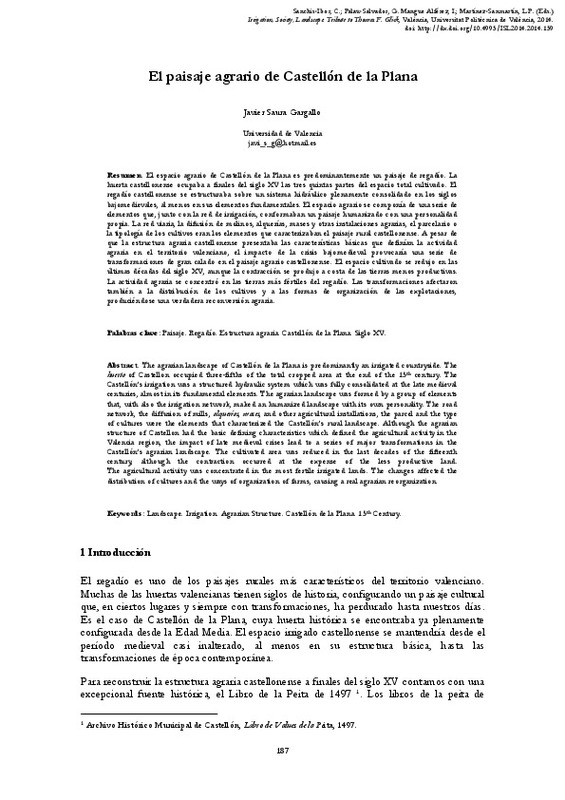|
Resumen:
|
[EN] The agrarian landscape of Castellón de la Plana is predominantly an irrigated countryside. The
huerta of Castellon occupied three-fifths of the total cropped area at the end of the 15th century. The
Castellón’s ...[+]
[EN] The agrarian landscape of Castellón de la Plana is predominantly an irrigated countryside. The
huerta of Castellon occupied three-fifths of the total cropped area at the end of the 15th century. The
Castellón’s irrigation was a structured hydraulic system which was fully consolidated at the late medieval
centuries, almost in its fundamental elements. The agrarian landscape was formed by a group of elements
that, with also the irrigation network, maked an humanized landscape with its own personality. The road
network, the diffusion of mills, alquerías, mases, and other agricultural installations, the parcel and the type
of cultures were the elements that characterized the Castellón’s rural landscape. Although the agrarian
structure of Castellon had the basic defining characteristics which defined the agricultural activity in the
Valencia region, the impact of late medieval crises lead to a series of major transformations in the
Castellón’s agrarian landscape. The cultivated area was reduced in the last decades of the fifteenth
century, although the contraction occurred at the expense of the less productive land.
The agricultural activity was concentrated in the most fertile irrigated lands. The changes affected the
distribution of cultures and the ways of organization of farms, causing a real agrarian reorganization.
[-]
[ES] El espacio agrario de Castellón de la Plana es predominantemente un paisaje de regadío. La
huerta castellonense ocupaba a finales del siglo XV las tres quintas partes del espacio total cultivado. El
regadío castellonense ...[+]
[ES] El espacio agrario de Castellón de la Plana es predominantemente un paisaje de regadío. La
huerta castellonense ocupaba a finales del siglo XV las tres quintas partes del espacio total cultivado. El
regadío castellonense se estructuraba sobre un sistema hidráulico plenamente consolidado en los siglos
bajomedievales, al menos en sus elementos fundamentales. El espacio agrario se componía de una serie de
elementos que, junto con la red de irrigación, conformaban un paisaje humanizado con una personalidad
propia. La red viaria, la difusión de molinos, alquerías, mases y otras instalaciones agrarias, el parcelario o
la tipología de los cultivos eran los elementos que caracterizaban el paisaje rural castellonense. A pesar de
que la estructura agraria castellonense presentaba las características básicas que definían la actividad
agraria en el territorio valenciano, el impacto de la crisis bajomedieval provocaría una serie de
transformaciones de gran calado en el paisaje agrario castellonense. El espacio cultivado se redujo en las
últimas décadas del siglo XV, aunque la contracción se produjo a costa de las tierras menos productivas.
La actividad agraria se concentró en las tierras más fértiles del regadío. Las transformaciones afectaron
también a la distribución de los cultivos y a las formas de organización de las explotaciones,
produciéndose una verdadera reconversión agraria.
[-]
|








